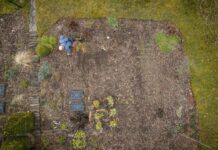Soil situated on a slope, exposed to the elements, has a higher susceptibility to rain, wind, gravity, and ice erosion. Luckily, you can protect your soil and stabilize it by using the following plants that help combat soil erosion. Consider these plants today to add beauty and practicality to your yard.
White dutch clover (Trifolium repens)
White Dutch Clover prevents soil from running off thanks to the extensive interconnected and thick root system that keeps essential nutrients like nitrogen in the soil.
This plant also produces thick clumps of showy white flowers and inhibits soil compaction. You can plant white clover as an annual in the winter throughout the southern U.S. or as a perennial in the North.
It grows in hardiness zones 4-9, blooms from the spring to the fall, tolerates full sun to partial shade, and needs well-drained soil. Your white Dutch clover seed has typical watering needs and grows between 8-12 inches.
Mondo grass (Ophiopogon japonicus)
Mondo grass is the perfect yard addition for those who live on the coast. This ground cover forms a mound with leaves resembling grass blades. It makes for the perfect alternative to turf grass, as it arches over the ground it covers. When it blooms in the summer, it produces bell-shaped lilac and white flowers and blueberries during the fall.
You can grow mondo grass in zones 7-10, requiring full sun and partial shade. If you ensure that you have moist, well-drained soil, this salt-tolerant plant grows between 6-12 inches tall.
Creeping juniper (Juniperus horizontalis)
Creeping juniper is an ideal plant to fight soil erosion. This shrub is easy to plant, grows low to the ground, and doesn’t require much maintenance once the roots get established. The evergreen needle leaves are a pleasant aqua green color, which turns purple in the winter.
They also provide a dense covering for your soil, with the creeping juniper getting as tall as 18 inches and then 6-8 feet wide. Gardeners can grow this plant in zones 3-9, in full sun, in sandy, rocky, and well-drained soil. Medium moisture is best to keep this plant thriving.
Spotted dead nettle (Lamium maculatum)
Spotted dead nettle has toothed, hairy, heart-shaped leaves, with a silver streak down the middle of the leaf. This ground cover plant blooms around May to June and brings forth pink, purple, and white flowers that are small with ruffles around the edges.
This plant spreads quickly, so it’ll protect your soil soon after you’ve planted it. It grows in zones 3-8, needs partial to full shade, and can tolerate clay, loam, sand, and humus-rich soil. Moist soils are best, and you have to water them moderately. With care, the spotted dead nettle grows 3-8 inches tall.
Riverbank lupine (Lupinus rivularis)
The riverbank lupine is a beautiful flower with a divine fragrance that gardeners love in their yards. The thick clusters of blue, white, pink, and purple blooms look amazing in your landscape and benefit your soil. The best part of the riverbank lupine is the five-foot taproot that stabilizes the surrounding soil when it penetrates deeply into the ground.
These roots also add nitrogen to the soil, fortifying it even further. Grow this plant in zones 7-9, in full sun, in moist soil that drains well. Expect a stunning 1-5 foot tall display to decorate your yard from spring to midsummer. Gardeners must beware that it is part of the legume family. Therefore, steer clear if you have an allergy.
Big blue lilyturf (Liriope muscari)
The big blue lilyturf is an evergreen, broadleaf flower with bright purple flowers that eventually become inedible berries after the late summer bloom. While you’ll need to ensure that the soil stays moist for the first year after playing the big blue lilyturf, it requires very little care after this point.
You’ll still be reaping the soil corrosion benefits that this dense plant offers, but it’s less than half the work it took to get it established. It grows in zones 5-10 with full sun to partial shade. This plant grows one to two feet tall.
Before you go
Remember that you can naturally control soil erosion problems by adding these beautiful plants to your yard to protect exposed soil. They’re all reasonably low maintenance, and the thick and colorful blooms are sure to add appeal to the landscape.































































